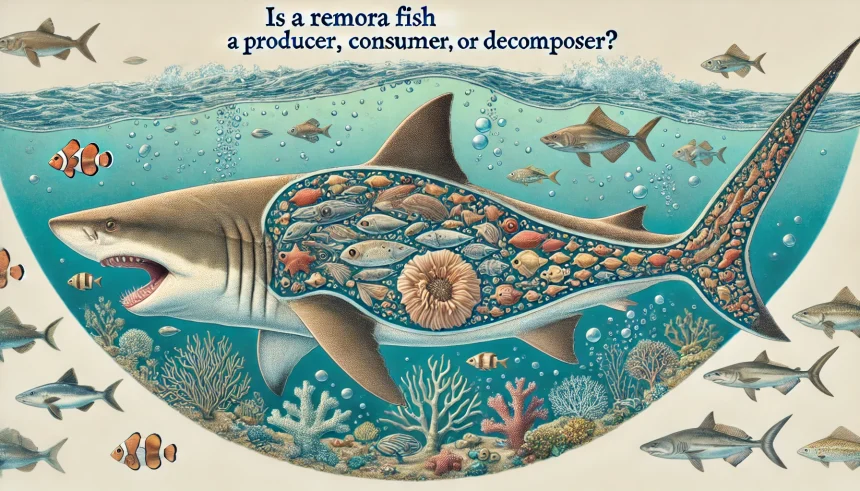The remora fish is a fascinating creature known for its unique relationship with larger marine animals. This small fish attaches itself to bigger creatures such as sharks, whales, and sea turtles using a specialized organ on its head. Understanding the role of the remora fish in the ecosystem can help answer the question: Is a remora fish a producer consumer or decomposer? This article will explain why the remora fish is classified as a consumer and what that means in terms of its role in the food chain.
What Are Producers, Consumers, and Decomposers?
To better understand the remora’s role, it’s helpful to define the three main categories of organisms in the ecosystem:
Producers
Producers are organisms that create their own food using sunlight, water, and carbon dioxide. Through a process called photosynthesis, they convert these elements into glucose, a form of sugar used for energy. Plants, algae, and certain bacteria are all examples of producers. Without producers, the rest of the food chain wouldn’t exist, as they provide the energy base for all other life forms.
Consumers
Consumers are organisms that cannot produce their own food and must rely on eating other organisms to gain energy. Consumers are classified into different types depending on their feeding behavior:
- Herbivores eat only plants.
- Carnivores eat only animals.
- Omnivores eat both plants and animals.
-
- Scavengers eat the remains of dead organisms.
Consumers play an essential role in controlling the population of producers and other consumers, thus maintaining balance in the ecosystem.
Decomposers
Decomposers break down dead plants, animals, and waste products into simpler substances, releasing nutrients back into the soil or water. These organisms, which include fungi, bacteria, and scavengers like vultures, play a vital role in recycling nutrients and keeping the environment clean.
What Type of Organism Is the Remora Fish?
The remora fish is best classified as a consumer. It does not produce its own food through photosynthesis, nor does it break down dead organic matter like a decomposer. Instead, it survives by feeding on food scraps, parasites, and detritus found on or around larger marine animals.
How Does the Remora Fish Feed?
The remora fish has a highly specialized way of obtaining food. It attaches itself to larger marine creatures such as sharks, rays, sea turtles, and whales. The fish uses a suction cup-like structure on its head to latch onto its host. This unique organ allows the remora to hitch a ride without expending much energy.
Here are the key aspects of how the remora feeds:
Feeding on Leftovers
As the remora stays attached to its host, it feeds on leftover food particles from the larger animal’s meals. For example, after a shark has finished eating, the remora picks up scraps from the shark’s meal. This feeding behavior helps the remora conserve energy because it doesn’t have to search for food on its own.
Eating Parasites
Remoras are also known to eat parasites, such as small fish or crustaceans, that live on the skin or in the mouths of their host animals. By cleaning its host of these parasites, the remora provides a beneficial service, which is why its relationship with the host is often referred to as commensalism. In this symbiotic relationship, the remora benefits from the food supply, while the host is cleaned of harmful organisms.
Energy Efficiency
By attaching to large animals that move through the water, the remora saves energy that would otherwise be spent swimming and searching for food. Instead, it can travel long distances while feeding on scraps without putting much effort into the hunt.
What Makes the Remora Fish Different from Other Consumers?
The remora fish’s feeding behavior is unique compared to other types of consumers in the ocean. Unlike predators, which actively hunt and kill other organisms for food, remoras rely on a more passive strategy. They don’t need to chase down prey; instead, they attach to larger animals and take advantage of the food and parasites available to them.
Other types of consumers in the ocean include:
- Carnivores, such as sharks, dolphins, and orcas, which actively hunt smaller animals for food.
- Herbivores, like certain fish and sea turtles, which graze on seaweed and algae.
- Filter feeders, such as baleen whales and certain species of fish, that strain tiny organisms from the water.
The remora is distinct from these animals because it doesn’t actively hunt or filter feed. It is more of a scavenger that benefits from its host animal’s actions.
Why the Remora Fish Is Not a Producer or Decomposer
The remora fish is neither a producer nor a decomposer.
Not a Producer
The remora fish does not engage in photosynthesis or create food from sunlight, making it not a producer. It relies on other organisms for food, and it does not contribute to the primary production of energy in the ecosystem.
Not a Decomposer
While the remora feeds on leftover food, it does not break down dead matter or recycle nutrients. Decomposers, like bacteria or fungi, are responsible for breaking down dead organic matter and returning nutrients to the ecosystem, a role that the remora does not play.
The Role of the Remora Fish in the Ecosystem
Even though it is a consumer, the remora fish plays an important role in the marine ecosystem. By feeding on food scraps and parasites, the remora helps to maintain the health of its host animals. In this way, the remora contributes to the overall balance of the food web.
Helping Control Parasite Populations
By eating parasites that live on the skin or in the mouths of larger animals, the remora helps reduce the number of harmful organisms on its host. This mutualistic behavior benefits both the remora and the host animal.
Assisting in Scavenging
Remoras also contribute to cleaning up the ocean by scavenging on leftover food. This helps to prevent waste from accumulating in the ecosystem.
Conclusion
In conclusion, is a remora fish a producer consumer or decomposer? The answer is that the remora fish is classified as a consumer due to its reliance on other organisms for food. Unlike producers, which make their own food, or decomposers, which break down dead matter, the remora feeds on food scraps and parasites from its host. Its unique feeding habits, which involve attaching to larger marine animals, make the remora an interesting example of how diverse the consumer category can be. The remora plays an essential role in its ecosystem by helping to clean its host and contribute to the balance of marine life.













